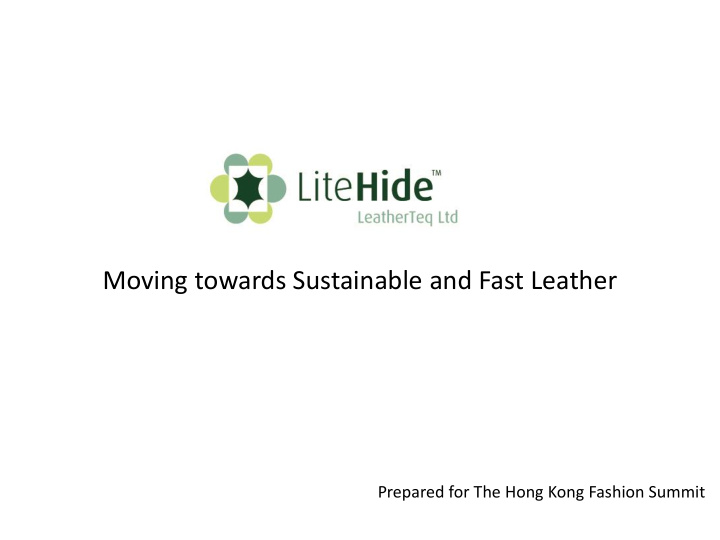



Moving towards Sustainable and Fast Leather Prepared for The Hong Kong Fashion Summit
The players in the industry • Meatpackers: harvest meat, hides a by product. • Tanners: convert raw hides into leather. • Brands and factories: convert leather into articles from handbags, belts to car seats. Why sustainability and fast leathers…? 2 Eliminating salt from the leather supply chain
Drivers for change Brands and customers recognising sustainability – 100% Traceability (positive list of countries). – Deforestation, animal welfare. – Sustainability reporting within financial statements (PUMA, Marks & Spencers). – Many industry and government organisations. 3 Eliminating salt from the leather supply chain
Needs Solutions that are: – Greener. – Not more expensive. – Accountable. – Improves current supply chain. – Benefits all parties in the supply chain. Previous efforts have focused on the tanners, being the heavy users of chemicals…. 4 Eliminating salt from the leather supply chain
Potential solutions at tanners • Recycling protocols. • Hair collection equipment. • Chrome free tanning. • New dyes – organic and biodegradable. • Waste and water management processes. • Energy management systems. However, these solutions only apply to tanners…. 5 Eliminating salt from the leather supply chain
A current problem at source…. • 90% of the world’s annual 311M bovine hides are preserved with salt • Average 20lbs of salt used per hide • Salt used in preservation is 60% of the TDS for a typical tanner • Salinity becoming a key issue in locations producing hides and receiving hides for leather making • India has banned salt in hide preservation – Tamil Nadur aquifer has salt creep • China not issuing new beam house (water works) licenses…. • Salted hides will continue to deteriorate • Can carry diseases, is pungent and dirty often with cow dung…. Salt used in preservation affects the whole supply chain 6 Eliminating salt from the leather supply chain
A new solution - Litehide ™ Litehide ™ packed for transport Litehide ™ pieces on a pallet next to traditional salted hides (unwrapped) 7 Eliminating salt from the leather supply chain
Benefits for all parties Meat packers: • Elimination of salt issues. • Potential harvest of collagen, additional income. • Waste reduction and storage benefits. Tanners: • Elimination of salt issues. • Transport savings, carbon emission credits. • Moving towards just in time manufacturing. • Inventory reduction, raw material storage versus finished leather inventory. Brands: • Sustainable leather. • Fast leather potential. • Traceability. • CSR adherence. 8 Eliminating salt from the leather supply chain
Potential cost savings Lower • Many times more Litehide ™ in the same transportation costs container compared to salted hides. • Litehide ™ does not spoil during transportation Non-perishable and can be stored indefinitely. • Litehide ™ allows for grain verification at source Pre-selection for pre-grading. 9 Eliminating salt from the leather supply chain
SCM • Can shorten shipping cycle by 8 weeks eliminating wait for hide shipment. • Long shelf life. • Enabling JIT production. • Neutral cure – flexible tannage. • Inventory cost reduction for tannery. 10 Eliminating salt from the leather supply chain
Summary • Solutions for change has to be multi-faceted addressing diverse groups of stakeholders. • Sustainability can be united with improved economics. • Consumers want value for money, sustainable, differentiating and on demand good. 11 Eliminating salt from the leather supply chain
Recommend
More recommend